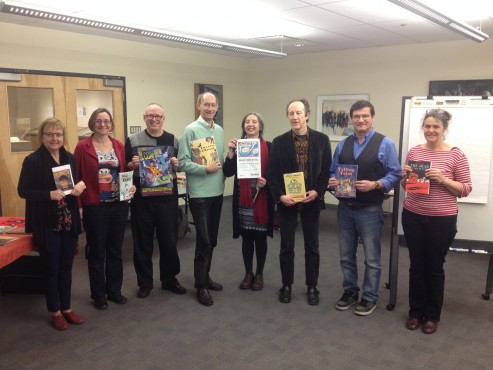As part of IdeaFest 2016, UVic presented Graphic Ideas on March 7: an interactive presentation exploring the many facets of comic books. Graphic Ideas boasted a plethora of presenters who showcased their comic books and graphic novels, some dating from as long ago as the 1880’s, and others so new they are still being drafted. Likewise, some literature came from as far away as Japan, while other works originated right here at UVic .
The event was a product of inter-departmental participation. Coordinated by the Department of French, Graphic Ideas saw contributions from the Departments of Curriculum and Instruction, Hispanic and Italian Studies, Germanic and Slavic Studies, Pacific and Asian Studies, and Visual Arts. The result was an international buffet of graphic literature.
Hélène Cazes, UVic French Department professor and event organizer said the event promoted the idea that the “graphic is free: freedom of format, freedom of language, freedom of topic, and when you read graphic novels you go into this zone [where] you feel empowered to make your own.”
To illustrate this idea, comics from 1887 printed in the French city of Épinal in North East France were showcased. Images D’Épinal, as they are called, came into existence during the French revolution and covered different themes.
“One major theme is religion,” said Immanuel Hérique of UVic’s French Department. “Another thing they would portray was moralizing stories for children. Images D’Épinal was the internet of the day.” Images D’Épinal were not simply comics; Hérique demonstrated that they could be extended into three-dimensional objects: “You have sheets where you would cut out figures and place them in battles.” These unique and imaginative works proved a long history of creative freedom in comics.
As the event also demonstrated, graphic novels have educational capabilities that go beyond mere entertainment. The book Mikomosisa and the Wetiko, a graphic novel illustrated by Camosun College comic students, is being used “across the country in law schools” according to the UVic Bookstore’s Lucy Bashford. “They are trying to introduce non-native students to how native law works and how European law works.” Mikomosisa and the Wetiko is available at the UVic Bookstore, along with many more of the showcased comics.
Beyond UVic, Graphic Ideas reached out to the community. Two classes from Arbutus Global Middle School attended as part of its pilot ’20 per cent’ program, modeled after Google: “20 per cent of the time, Google’s employees get to work on whatever they want,” said Kelli Meredith, a teacher at Arbutus. “And some of their best innovations have come from [that] 20 per cent time. That’s what we are trying to emulate.”
“I know a lot of the kids are interested in graphic novels. A lot of our students are interested in art as well. We thought it would be a good opportunity to check it out, and try the art out themselves, and see what else is out there.”
Perhaps the most unusual, but fitting, aspect of the whole event was that visitors were given a pen and paper and allowed to vent their own creative outlets, making comics in real time. “The first year we [put on the event it was] like a mini symposium. This year we made sure it’s a big mess and that we just enjoy ourselves,” said Cazes.









